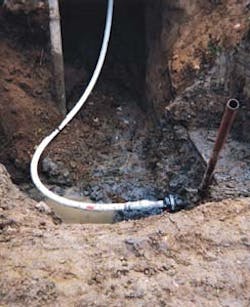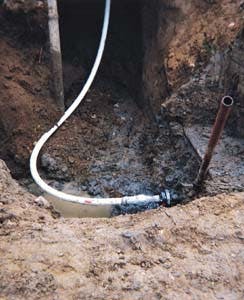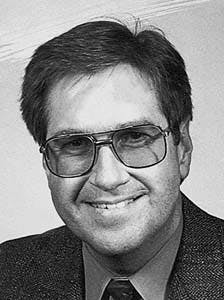Flexible pipe combats corrosion threat at sour brine injection site
Donald H. Wolfe
ProFlex Pipe Corp.
EdmontonJohn J. Baron
Shell Canada Ltd.
Calgary
A flexible pipe installation is ready for backfill (Fig. 2).Shell Canada Ltd. has installed flexible composite pipe for high-pressure, produced sour brine injection for enhanced oil recovery at its Virginia Hills unit in northwest Alberta.
The pipe is to combat corrosion caused by high-chloride sour brine at 55° C. and structural stresses. These stresses are caused by thermal expansion and cyclic-related loading from alternating water and hydrocarbon solvent flooding.
The high-density polyethylene (HDPE) liner which forms the innermost layer of flexbile composite pressure pipe sets up a long-term, chemically resistant barrier to various oil field environments, including sour brine.
In the context of declining oil production, Shell adopted a program of scheduled preventive maintenance to provide a safe and cost-effective pipeline infrastructure.
Internally coated steel risers and cement-mortar-lined (CML) steel elbows were identified as areas of potential trouble to be addressed through selective replacement before failure.
Various piping systems were considered; both rigid fiber glass and flexible composite pressure pipe were installed.
Virginia Hills
The Virginia Hills field is divided into the original Virginia Hills battery dating to 1957 and the smaller Belloy Shunda battery added in 1978.
The field consists of 94 producing oil wells and 40 injection wells. Current production of 11,000 b/d represents a decline from more than 20,000 b/d in the early 1970s.
Together with neighboring Swan Hills, Judy Creek, and Carson Creek, which also tap the Beaverhills Lake limestone formation at 2,400-2,700 m, this area 250 km northwest of Edmonton has been one of Canada's most prolific oil fields, with aggregate production of more than 2 billion bbl.
Virginia Hills has 480 active oil emulsion gathering, water, and solvent-injection pipelines totaling 321 km in length.
CML steel pipe has been used for all oil-emulsion pipelines; and both CML and HDPE-lined steel have been used for water-injection pipelines.
As does adjacent fields, Virginia Hills extensively employs enhanced oil recovery (EOR) schemes, including produced-water injection dating to 1963 and solvent flooding to 1989.
Solvent recovery is about half completed.
In 1989, most of the pipeline infrastructure was replaced with CML steel for oil-effluent gathering lines, HDPE-lined steel for water lines, and internally bare steel for solvent lines.
Oil-recovery temperatures in the Virginia Hills battery are currently 80° C. (175° F.). With a water cut of 80-90%, the resulting produced water-injection temperature has now pushed beyond 55° C. (140° F.).
This represents a significant increase from the 30° C. temperatures experienced in 1970. The adjacent and newer Belloy Shunda battery is operating at somewhat lower recovery and injection temperatures of 60° C. and 50° C., respectively.
Shell maintains production rates to moderate these temperatures.
With an age of 7 years, the CML steel pipelines and newer polyethylene-lined pipelines have generally performed satisfactorily. Specific areas currently addressed by Virginia Hills personnel through preventive maintenance are risers and elbows.
Internally coated steel risers have been used for the directional transition from below to above grade for both CML and HDPE-lined pipelines.
External and internal corrosion has been experienced, primarily because of the effect of higher temperatures on coating materials and the difficulty of properly installing internal coatings within riser-spool assemblies.
Certain areas have been more problematic, such as flange face corrosion. Higher operating temperatures and cyclic pipeline expansion due to the WAG injection scheme have created instances of 45° and 90° CML elbow deformation, with resulting cement liner cracking and ensuing corrosion failure.
(WAG = Water alternating with gas. Shell's Virginia Hills is a produced water and ethane-injection program for tertiary recovery of oil.)
Maintenance; alternatives
In its process of identifying and field-testing alternatives for selective riser replacement, Shell initially chose anhydride-cured epoxy resin fiber glass line pipe.
The specified rigid fiber glass piping system was rated to 3,000 psig at 80° C. and was joined with API 8 round threads. Fiber glass elbows and flanges were supplied by the same manufacturer to the same pressure rating.
The fiber glass riser assemblies employed a fiber glass flange at one end and SS316 flange at the other, were field-fabricated with thread sealant, and installed with personnel supplied by the Canadian product distributor.
Seven fiber glass riser assemblies were installed from May 1995 to connect produced-water trunk distribution pipelines to individual wellhead metering buildings administering the alternating water and solvent-injection program.
Flexible composite pressure pipe was also considered and used for this application. Shell Canada became aware of the technology in late 1992 and had participated in its research and development through consultative input on performance requirements and material testing.
Shell was aware of other producer activity in assessing the product and remained in contact with the engineering personnel of these producers to monitor other installations.
In August 1995, Shell installed its initial segment of flexible pressure pipe in a similar installation and operating configuration to the rigid fiber glass pipe.
Flexible pressure pipe
The flexible pressure pipe supplied to Shell is a lightweight and corrosion-resistant pipe made from fiber-reinforced composite, polymer, and elastomeric materials.
The product consists of an inner thermoplastic liner, surrounded by multiple independent cylindrical structural layers and an outer cover.
Each of the structural layers consists of thin, parallel, helically oriented, continuous fiber-reinforced composite strips separated by thermoplastic elastomer strips.
Low bending stiffness is achieved simultaneously with high structural strength by composite and elastomer materials in discrete helical strips. Their dimensions and helix angles define product performance.
Flexible, composite pressure pipe, a product of ProFlex Pipe Corp., Edmonton, is made in sizes to 4 in. and pressure ratings to 3,000 psi. It can be coiled for storage or used to a bend radius of 15D (D = diameter).
The pipe is designed to exhibit neutral axial strain from internal pressure and is half the weight of standard schedule steel pipe. It resists internal and external corrosion from aqueous solutions.
Used as a flexible pipeline riser or connector to well heads or plant equipment, the pipe has applications in produced H2O, multiphase oil and gas, CO2, hydrocarbons, chemical, or waste pipelines.
The pipe's flexibility allows it to accommodate ground settlement or movement.
Pipe testing and qualification began in 1991, field installations in 1994. The pipe is now used by 20 Canadian oil and gas producers.
Connections; handling
The pipe is joined with conventional steel flanges and provides a connection with greater resistance to structural loads than the pipe itself.
The strength of the connection relative to that of the pipe body has been tested and documented through static and cyclic end connection tensile testing and repeated short and long-term pipe destructive testing.
A liner stub-end which extends the inner polymer liner through the flange connection provides continuous corrosion and abrasion resistance from flange face to flange face.
The impact resistance of flexible composite pressure pipe and its relative impact resistance compared to internally coated steel, bare steel, and fiber glass pipe have been determined and documented.
The recommended test procedures of ASTM D2444 and API 15LR were followed. The pipe was tested both empty and filled with water.
Testing was carried out from -40° to 175° F. At all temperatures, the pipe was impacted from 15 ft using 4 and 1-in. diameter drop weights of 9.4 lb.
The pipe experienced no damage or reduction in performance, and the impact energy was dissipated in the structural layers.
Engineering, Phase 1
Shell's 1991 flexible composite-pipe test program objective was to install an initial short section of 3-in. flexible composite pipe to gain installation and operating experience.
As with the rigid fiber glass riser assemblies, the flexible pipe was used to connect a produced-water trunk distribution pipeline to an injection wellhead metering building in the Virginia Hills complex.
The design and operating conditions for the initial test installation are shown in the accompanying box.
In addition to the design conditions specified by Shell, ProFlex established acceptable tolerances for flexible pipe torque and axial growth.
Because of its multiple-layer structure, a characteristic of flexible pipe is its ability to be designed through modification of design variables to generate a specific but predetermined negative, positive, or neutral response in rotation and axial elongation from internal pressure.
In a pipeline, the desired response is typically neutral. Maximum levels of torque and axial growth of 500 ft-lb and 0.25%, respectively, were established by ProFlex engineers. Flexible pressure pipe specimens were made to this design and performance tested to ensure compliance.
Fig. 1 [38064 bytes] shows the axial and torsional responses from internal pressure for flexible composite pipe tested at 20° and 60° C. (70° and 140° F.).
ASME B31.3 "Chemical Plant and Petroleum Refinery Piping" and CSA Z662 "Oil and Gas Pipeline Systems" were used as guides throughout the design, fabrication, and testing of the product. These codes set forth the engineering requirements for safe design and construction of pressure-piping installations.
The scope of these codes prescribes requirements for the materials, design, fabrication, assembly, erection, examination, inspection, and testing of piping for a variety of services, including petroleum products and water.
This compliance included examination and analysis of materials employed in the product to determine their suitability for long-term service.
The selection of HDPE for the inner liner was based on extensive industry experience within the service temperature envelope and by long-term coupon test data generated by ProFlex and its material suppliers in consultation with Shell Canada and other end-user companies.
The Alberta Energy and Utilities Board (AEUB), the regulatory body for pipelines in Alberta, was notified of the installation.
Testing; field
Testing consisted of performance verification to measure compliance with torsional and axial mechanical and temperature response criteria in both straight and bent configurations.
To determine the long-term hydrostatic pressure, ProFlex adopted the test method prescribed in ASTM D2992, Procedure B, "Standard Practice for Obtaining Hydrostatic or Pressure Design Basis for Glass-Fiber-Reinforced Thermosetting-Resin Pipe and Fittings."
Multiple pipe specimens were tested in a bent configuration, torsionally restrained and axially unrestrained. Testing at both 23° C. and 60° C. was conducted at a bend radius of 43 in., 15D of the inner liner diameter.
All results used in the determination of long-term hydrostatic design pressure were based on tests performed at a minimum of 60° C. The long-term hydrostatic design pressure was estimated to be 38,600 kPa (5,600 psi) for a 20-year design life.
The flexible pipe test section was supplied with 3-in. ANSI 1,500-lb steel flanges at each end. The spool would connect a polyethylene-lined steel pipeline approximately 3 m belowground to a manifold in the metering building about 1 m aboveground.
Cathodic protection was maintained for the adjoining steel pipeline. In addition to daily inspection, the pipeline was protected by a shutdown facility which monitored flow rate.
Shell provided all excavation and pipefitting required physically to install the test section, and ProFlex provided on-site technical assistance on flange make-up procedure.
Shell's initial flexible pipe installation was carried out on Aug. 14, 1995.
The pipe was hand-bent in the field by a two-man work crew and aligned into a J-shape to join the below-grade horizontal pipeline flange to the above-grade metering building header flange. Flanges were bolted-up with steel studs and nuts.
The resulting minimum bend radius of 57 in. was 20D of the liner outer diameter. The pipe required no special support along its length.
Although no special backfill materials were specified by the manufacturer, Shell covered the pipe with approximately 2 ft of sand because it was readily available.
Engineering: Phase 2
Based upon the favorable initial installation and the positive response of field personnel about handling and installation of the product, Shell proceeded with a second installation of flexible pressure pipe with identical design and operating conditions.
In addition, Shell asked that the product be supplied with an integral reducer to provide the dimensional transition from the 4-in. group pipeline to the 3-in. wellhead piping.
This necessary dimensional reduction was previously accomplished with a 4 x 3 in. stainless steel (SS316) reducer spool with back-to-back flanges.
ProFlex was able to engineer and supply the product with an integral reducer, resulting in flexible pressure pipe with 3 and 4-in. ANSI flanges at the two ends, thus reducing the cost and inconvenience of this additional component.
The second installation of flexible composite pressure pipe was carried out during winter 1995 at -30° C. to determine the installation characteristics of the product in Canadian winter. Again, the flexible pipe was hand-shaped in the field to fit and installed without difficulty.
Fig. 2 shows the completed tie-in ready for backfill.
Five additional installations of flexible composite pressure pipe were installed by Shell Canada at Virginia Hills in July 1996.
Evaluation; future
The connection, which provides complete mechanical attachment of the flexible pipe structural layers to the steel flange without interlaminar shear dependency, appears to be less susceptible to failure from this type of cyclic temperature environment.
Of the seven fiber glass pipe assemblies installed from May 1995, three failed within 6 months. All have been removed and replaced with flexible composite pipe.
All of the seven flexible composite-pipe installations from August 1995 remain operating without problem or maintenance. Shell determined that failure of the rigid fiber glass pipes was caused by separation between the pipe body and the end flange resulting from the cyclic temperature service.
In addition to continuing evaluation of flexible composite pipe for riser replacement, Shell is now considering the product for selective replacement of CML elbows which are subject to deformation from pipeline thermal expansion.
Acknowledgments
The authors thank Shell Canada and ProFlex Pipe personnel in Calgary, Edmonton, and Virginia Hills for their contributions.
The Authors
Donald H. Wolfe is the chief executive officer of ProFlex Pipe Corp., Edmonton.
John J. Baron is head of nometallic materials engineering for Shell Canada Ltd. He was the nonmetallic materials specialist for Shell's Caroline project, working on the field gathering system, gas plant, and sulfur pipeline.Baron has a diploma in petroleum technology from the Southern Alberta Institute of Technology, Calgary. He is chairman of the CSA Plastic Pipe Task Force and the NACE International Membership Committee.
Copyright 1997 Oil & Gas Journal. All Rights Reserved.



